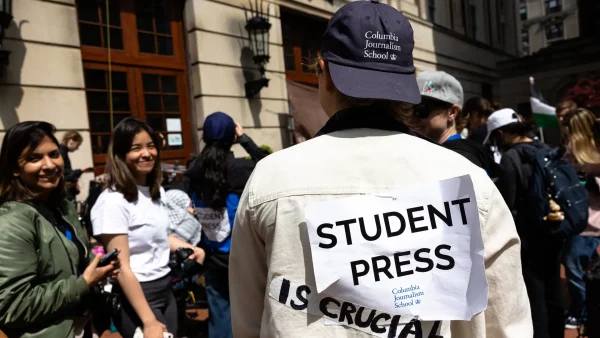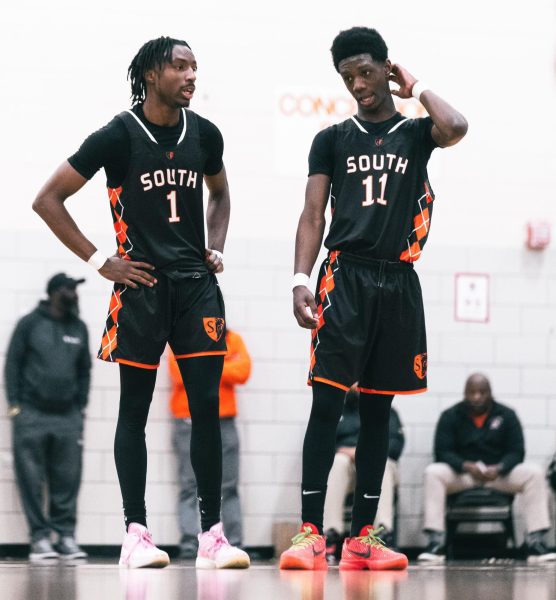Lack of district resources makes it harder for visually impaired students
Pictured above freshman Haney Mohamed and her SEA (special education assistant), Laura Anderson with students Sasha Rapacz (left) and Beatrice Kennedy-Logan (right) in the background. In this photo, Anderson copies definitions from the board into Mohamed’s notebook and explains the information that she cannot see. “When teachers write on, let’s say a white board: visually impaired people cannot see the whiteboard. The SEA’s explain what is written, they tell them what it says,” said Haney Mohamed. This extra help is vital for a successful schooling experience for students with visual impairments. Picture: Kinsley Wilcox-McBride
From copying notes written on a board, to receiving a text book or packet, things most students perceive as basic, everyday things can be frustrating complicated processes for individuals with visual impairments.
What is often the biggest setback for blind students is the amount of time for it takes getting reading material translated into braille texts. Braille is a form of written code consisting of raised dots which can be felt by the fingertips of blind or low sight people.
Simple one page handouts or shorter packets are fairly quick, but when there things such as textbooks or novels are handed out, students will find themselves falling behind in the time it takes to receive the proper materials. “Sometimes I am behind…brailling takes a long time, so I will fall behind,” shared student Haney Mohamed.
One preventative measure teachers can take in the step to keep visually impaired students on track with the rest of the class is to plan materials out months ahead of time and communicate this to students themselves (if the student is that independent at this point) or staff working within the special needs program who can then place orders for the braille, therefore getting it to school by the time the class lesson the material is needed in rolls around. “If we’re looking at a textbook, we generally have to request those the spring of the year before for the next year.” said visual disability specialist Jessica Laven.
“Getting braille stuff quicker so that I don’t fall behind is important to me. Then I would be reading the things that the other students were reading,” said Mohamed. She expressed how much she would appreciate to be truly in sync with what the rest of her peers are doing in class, and emphasized the importance of planning on the part of teachers.
“In certain aspects, I would say that accommodations [South] provides are good but there are certainly places where the process in which you obtain your accommodations is extremely inefficient” said Senior Rakeb Max, who has also felt the negative effects of issues like long Braille waits.
However, it should be made clear that many issues these students are faced with are not the direct fault of the teachers in the school. “I would definitely say its administration and just, MPLS politics,” said Max.
A vital element of the schooling experience for students with visual impairments is the support and extra help they are offered. Encouraging classmates, teachers who are well prepared to teach a diverse group of students, and most importantly, aids who are there to assist students throughout the day are all important in making a safe and comfortable environment for students with disabilities. “[Staff and students] make me feel like this is my home school…it’s a good environment,” said Mohamed.
A major issue in the area of special education in general is the effect that school budget cuts and shifts have had on how special ed is functioning. With a limited amount of money, things such as staff aids for students are being jeopardized. “There have been budget cuts, so the administration has been wanting to limit the amount of time special education assistance spend with students. That directly affects students like me who are lower need,” said Max. :I still need an aid in my math and science classes but because they decide to look at the students here they think ‘Rakeb doesn’t need them; she only uses them for two periods so we will just take her math aid away.” The same situation is being presented to other special needs programs at South as well, students with higher functioning autism could be at risk for having the help that they need.
These staff are hoping for a change because most would say that they are crucial to the experience of every disabled student. One example of the support they provide, Mohammed says is, “when teachers write on, let’s say a white board: visually impaired people cannot see the whiteboard. The SEA’s (special education assignment) explain what is written, they tell them what it says.”
Many staff, family, and students connected to special needs programs think the administrative issues go deeper than simply not having enough money available. In fact, there has been a significant amount of money poured into the programs over the past few years “I think a major problem is that a lot of people don’t think that special education students are an important investment, and the truth is that it is an extremely important investment! If you are able to invest in that special education student in high school you’re giving them a better chance of finding something they can do after graduation, that’s less money you as a taxpayer has to pay towards them going into an institution,” said Max.
An essential part of setting a student with visual impairments up for success are the connections they make. “Typically a teacher is alerted that they are going to have a student with an IEP (Individualized Education Program) or 504 plan a few days before the school year starts, so establishing a connection with that student is certainly very important,” said Max. IED’s and 504 are two different forms of specialized plans for students with any type of physical, mental, or behavioral issue, and so on. An IEP is a more specific plan, applied to more extensive situations. Simply said, a 504 plan is easier to get as it will typically consists of a students personal needs within classes, while an IEP specifies more needs, such as classroom aids, special needs classes, or whatever other special accommodations a student requires.
Many students and parents believe that counselors, casemakers, and any other specialists who work with special needs children should make sure they are close enough with that student to understand what they need.
“I’ve read numerous articles of parents being extremely frustrated with how special education works because their kids will have IEP’s but they feel that caseworks aren’t understanding the student to the extent that they should be,” said Max. She shared that many caseworkers-specialists in charge of keeping tab on and creating individualized plans for student success, which could include determining what special classes or extra assistance a blind student may need-have a significant amount of students to work with at a time, putting a strain on their ability to truly connect with each one.
In addition to cuts affecting the aid students receive, there is also a shift in what program many students are being put in. “There’s a big push to put students in a resource setting for special ed” said a staff member who has chosen to remain anonymous for the purpose of this article. Students who were initially in special programs or intensive programs are now being funneled into classes with what are called resource teachers, in turn making a decrease in Special Ed classes themselves. In special programs, there are times where SEA support is needed; which will not happen while students are in a “resource center” type of special ed track. “What they don’t have is any aids specifically for resource so as they are shifting students from special programs to resource, the general ed teachers need to pick up the responsibility for these students and they’re not getting the aid support.” said the anonymous source.
However, in an email interview regarding this issue, vice Principal Reynolds denied the occurrence of these placement switches. “The support that students get in their classes is based on their IEP goals and objectives and decisions made by the students’ IEP team,” said vice Principal Reynolds, despite what Max shared about having her aid support removed in certain classes.

Kinsley Wilcox McBride is a senior at South now in her fourth year of newspaper. She served as Features editor last year and is excited to be editor in...










